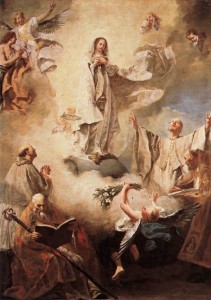 “Let us celebrate the Immaculate Conception of the Virgin Mary: let us adore her Son, Christ the Lord.” (Matins response)
“Let us celebrate the Immaculate Conception of the Virgin Mary: let us adore her Son, Christ the Lord.” (Matins response)
Historically, our belief in the doctrine of the Immaculate Conception has its roots in the fifth century Church in Syria. Looking at the lex orandi tradition and the teaching of the Fathers, this doctrine had currency in the East and the West. Studies in historical theology that the Church in the East was more attune to this teaching about Mary in the Patristic times than the Church in the West. We know from what some Fathers said, like Saint Ephrem (306-373) to the Mother of God: “Full of grace . . . all pure, all immaculate, wholly without sin, wholly without stain, wholly without reproach . . . virgin in soul, in body, in spirit.” Saint Andrew of Crete (650-740) even uses the expression “holy conception” in reference to Our Lady; and Saint John Damascene (676-749) exclaimed: “O admirable womb of Anne, in which developed and formed little by little an infant all-holy.” Among the Eastern Churches there is the liturgical celebration of Saint Anne conception of Mary, a feast that existed in the East as early as the eighth century. There are many Eastern churchmen who protest the connections made between the East and West but the announcement of salvation comes through the announcement to Saint Anne that she was going to bear a daughter destined for something incredible that would change world history; the very idea that the conception of Mary was in some way, a mystery, a holy event and person that could not not be intended for be for our salvation.
Hence, the theologians and Pope Pius IX could conclude their investigations in the 19th century by saying, “The illustrious monuments of tradition, of both the Eastern and Western Church, most convincingly testify that this doctrine of the immaculate conception of the most Blessed Virgin . . . always existed in the Church, as received from those who lived before and as marked with the character of a revealed doctrine” (Rome, Analecta juris pontificii, I, 1215).
later generations have tended to confuse the doctrine with the virginal conception of Christ and even gone so far as to assume that Catholics believe Mary had no need of redemption. The papal declaration of Blessed Pope Pius IX, Ineffabilis Deus, makes eminently clear, Mary, like each one of us, was redeemed by Jesus Christ, the Savior of the human race. In the case of Mary, she had a exceptional in being without original sin and giving birth to the Savior.
Through the centuries theologians like Saint Bernard (1091-1153), Saint Thomas Aquinas (1225-74) and Blessed John Duns Scotus (1266-1308) expressed various opinions about the teaching of the Immaculate Conception. Aquinas, for example, had some reservations about how to conceive of the teaching properly.
Blessed John Duns Scotus writes well of the Blessed Mothers as when he says that “Mary most assuredly needed Christ as a Redeemer, for she would have incurred original sin in the usual way from her parents, if she had not been preserved by the grace of the Mediator. Just as others needed Christ that sin already incurred might be forgiven by his merit, so she needed the preventive action of the Mediator all the more, that there might not be any sin to be incurred, and that she might not incur any.”
The Franciscan School (among whom we would count Saint Bonaventure, Scotus, Alexander of Hales, William of Ware) prevailed with Pope Pius IX, at the behest of a majority of the bishops, formed a coetus (1851 to 1853) which then formed the solemn definition.
In 1854, the papal declaration,
“We declare, pronounce, and define that the doctrine which holds that the most Blessed Virgin Mary, in the first instance of her conception, by a singular grace and privilege granted by Almighty God, in view of the merits of Jesus Christ, the Savior of the human race, was preserved free from all stain of original sin, is a doctrine revealed by God and therefore to be believed firmly and constantly by all the faithful.”
The Latin: Declaramus, pronuntiamus et definimus doctrinam quae tenet beatissimam Virginem Mariam in primo instanti suae conceptionis fuisse singulari Omnipotentis Dei gratia et privilegio, intuitu meritorum Christi Jesu Salvatoris humani generis, ab omni originalis culpae labe praeservatam immunem, esse a Deo revelatam, atque idcirco ab omnibus fidelibus firmiter constanterque credendam. (Cf. Denz., n. 1641)
The pope also wrote, “He [God] attended her with such great love, more than all other creatures, that in her alone He took singular pleasure. Wherefore He so wonderfully filled her, more than all angelic spirits and all the Saints, with an abundance of all heavenly gifts taken from the treasury of the divinity, that she, always free from absolutely every stain of sin, and completely beautiful and perfect, presented such a fullness of innocence and holiness that none greater under God can be thought of, and no one but God can comprehend it.”
For more info, see the entry in the Catholic Encyclopedia or a briefer review of the teaching by Fr William Most. But nothing will substitute your reading of the 1854 Apostolic Constitution of Pope Pius IX, Ineffabilis Deus.
Mary Immaculate,
Merely a woman, yet
Whose presence, power is
Great as no goddess’s
Was deemèd, dreamèd; who
This one work has to do—
Let all God’s glory through,
God’s glory which would go
Through her and from her flow
Off, and no way but so.